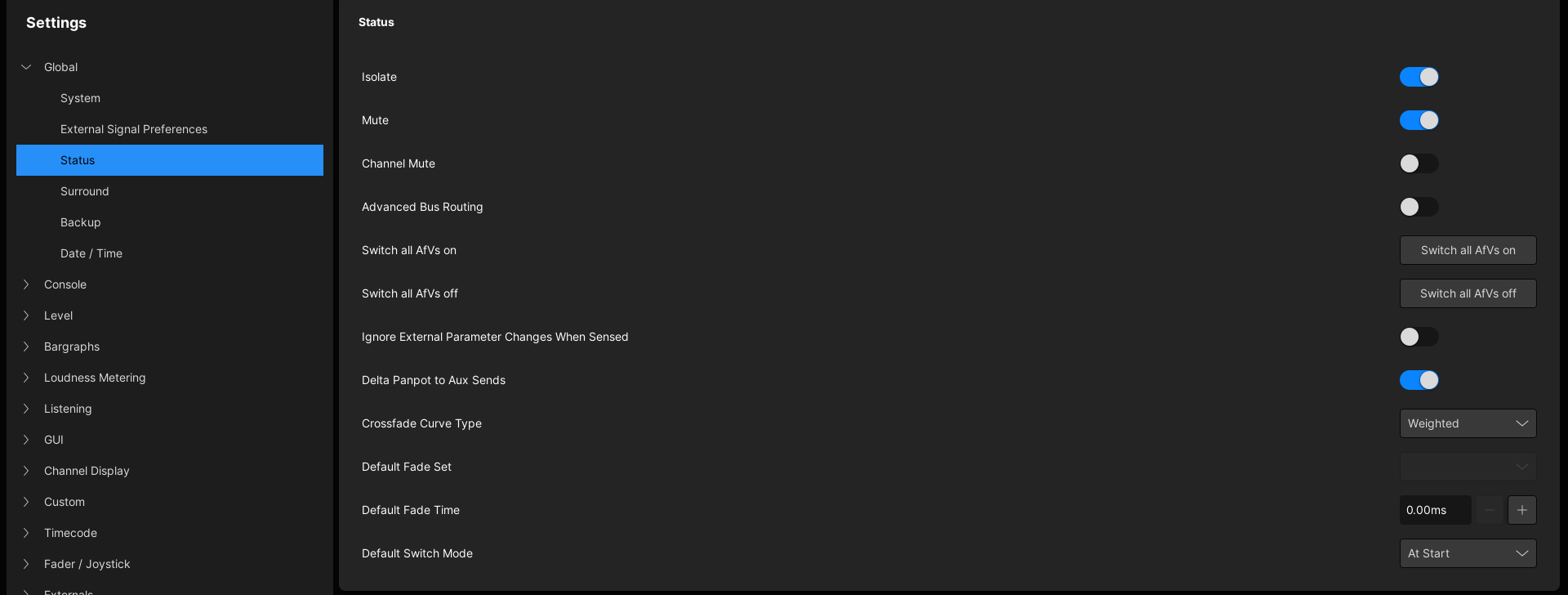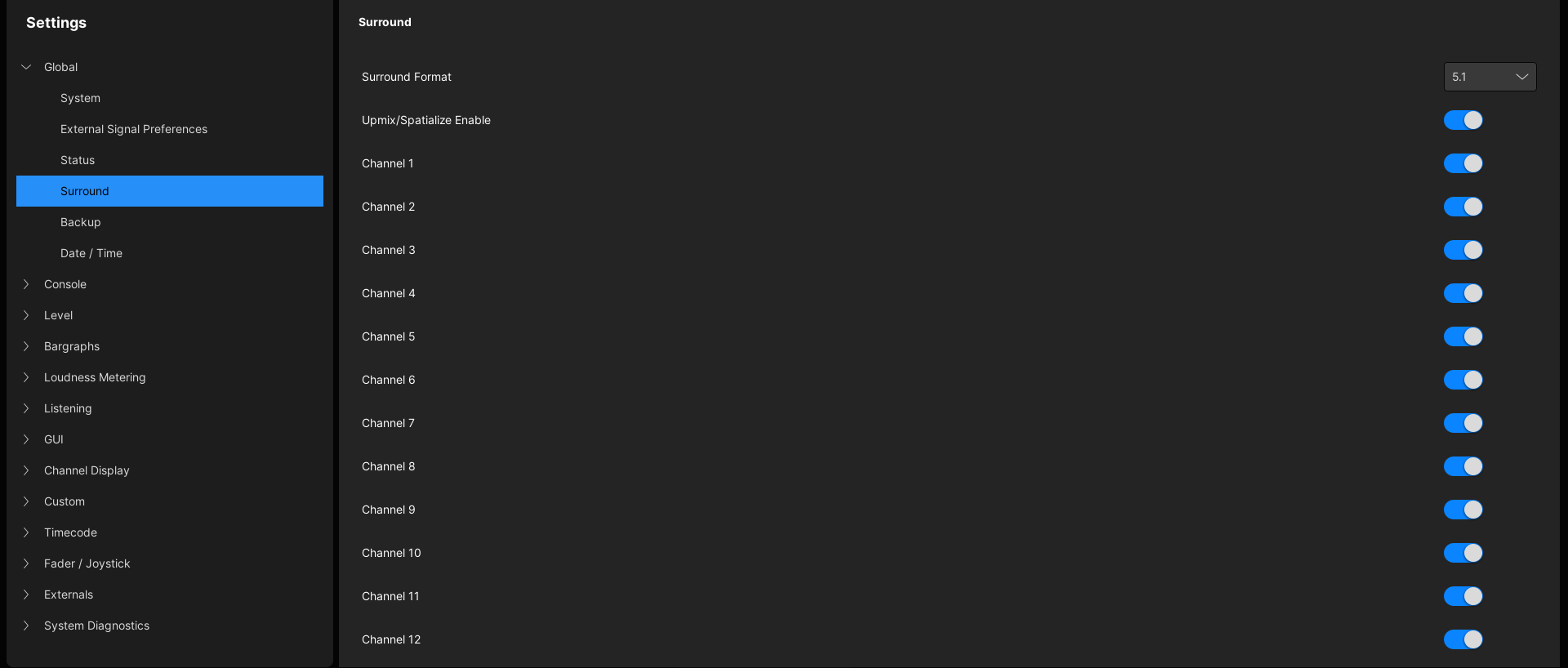mc²56 - System Settings -> Global
The Global options define system-wide options.
Global → System

Product Versions & System Variant
The first three fields are for display purposes only. They should be noted if you need to report an issue to the Lawo support department.
- Product Release Version – this is the release version of the product software.
- Product Control Software Version – this is the release version of the control system software.
- Control Software System Variant – this is the system variant (e.g. mc256 mk3).
IP Address Primary (& Secondary)
This field is for display purposes only. It shows the IP address of the mc2 control system.
If a redundant control system is configured, then a second field is visible showing the IP address of the secondary control system.
Prepare Coldstart
This option determines what happens when the control system next starts up.
- Prepare Coldstart (off) = the system will warm start (and load the settings saved at the last shutdown).
- Prepare Coldstart (on) = the system will cold start (without loading the warm start data).
By default, the option is set to off. Turn the option on, and then trigger a restart, if you wish to reset to the settings stored in the cold start configuration.
Note that, after the restart, the option resets to off. This ensures that the default start-up mode is always a warm start.
For more information about warm and cold starts, please see mc²56 - Power On: FAQs.
Keyboard Layout
This option defines the layout for the console keyboard layout: either US English or German. The new layout will take affect after a GUI reboot. To reboot now, choose Yes in the confirmation pop-up.
Global → Redundancy
If a redundant A__UHD Core is configured, then the Redundancy sub topic become visible.
There is a single option: A__UHD Core Redundancy - Manual Takeover. You can use this option to force a manual takeover to the slave device (as described earlier).
Global → External Signal Preferences

Parameter Synchronization Direction
This option determines what happens to signal parameters whenever the control network connection is made to an external device. It can be set to one of two states:
- Network to Local = signal parameters on the external I/O device remain unchanged (and the console updates).
- Local to Network = signal parameters on the external I/O device are reset to the current console settings.
Share Group Override Timeout
ADD DESCRIPTION
Global → Status

Isolate
This option enables or disables the SNAP ISO (Snapshot Isolate) buttons across the console. You can turn the option off to ensure that all channels are reset by a snapshot load.
- Isolate (on) = permits the selection of SNAP ISO buttons (to isolate channels from a snapshot or automation load).
- Isolate (off) = prohibits the selection of SNAP ISO buttons across the console; any existing SNAP ISOs are cleared.
Mute
This option enables or disables the fader strip MUTE buttons across the console. You can turn the option off to prevent accidental muting of channels during a live production.
- Mute (on) = permits the selection of channel MUTE buttons (to mute/cut a channel).
- Mute (off) = prohibits the selection of channel MUTE buttons across the console; any existing channel MUTEs are cleared.
Channel Mute
This option determines the position of the channel mute in the signal flow. It is a global setting that affects all channels. You can turn the option on if you wish the MUTE button to mute all sends from a channel, including those that are pre-fader.
- Channel Mute (on) = the MUTE button mutes the channel after the input mixer; all channel outputs (except PFL) are muted.
- Channel Mute (off) = the MUTE button mutes the channel after the fader; only post-fader outputs are muted, pre-fader sends remain active.
Advanced Bus Routing
This option allows Aux and Sum channels to be assigned to Groups, Auxes and Sums. You can turn the option off to prevent accidental feedback loops. Alternatively, turn the option on to make the bus routing more flexible.
- Advanced Bus Routing (on) = permits the assignment of Aux and Sum channels to Groups, Auxes and Sums.
- Advanced Bus Routing (off) = prohibits the assignment of Aux and Sum channels to Groups, Auxes and Sums; any existing assignments are cleared.
Switch all AFVs on or off
The next two options can be used to switch all AFV (Audio Follow Video) events on or off across all channels. In each case, either touch or click on the option.
- Switch all AFVs on – AFV is switched on across all channels.
- Switch all AFVs off – AFV is switched off across all channels.
Ignore External Parameter Changes When Sensed
Enable this option if you wish to prevent parameter changes while a console front panel control is being sensed. For example, to prevent an external override from a remote device (via Ember+).
Delta Panpot to Aux Sends
This option determines whether aux send panning follows channel fader panning, across the console, for stereo aux sends:
- Delta Panpot to Aux Sends (on) = aux panning follows channel fader panning.
- Delta Panpot to Aux Sends (off) = aux panning can be set independently from channel fader panning.
Crossfade Curve Type
The crossfade curve type for snapshot crossfades can be changed from linear to weighted, or vice versa. This option affects all variable parameters that are selected to crossfade.
Default Fade Set, Fade Time & Switch Mode
The next three options set the default parameters for snapshot crossfades. They are applied whenever a new cuepoint is added to a cuelist.
Global → Surround

Surround Format
This option defines the global surround format used for surround channels, panning laws and monitoring. Use the drop-down menu to select an option.
The available 2D formats are as follows.
- 4.0 – Dolby ProLogic (L, R, C, Cs).
- 5.1 – ITU-R BS.775 (L, R, C, LFE, Ls, Rs).
- 6.1 – Dolby Digital EX & DTS ES (L, R, C, LFE, Ls, Rs, Cs).
- 7.1 SDDS – SDDS (L, R, Lc, Rc, C, LFE, Ls, Rs).
- 7.1 DTS-HD – ITU-R BS.2051 (L, R, C, LFE, Lss, Rss, Ls, Rs).
The 3D formats combine a 2D base layer with an ITU-R BS.2051 compliant top layer in one of three variants:
- .2 (Ltm, Rtm),
- .4 (Ltf, Rtf, Ltb, Rtb), or
- .6 (Ltf, Rtf, Ltm, Rtm, Ltb, Rtb).
In addition, a 4.0.4 helper format is provided that combines a L, R, Ls, Rs base layer with a Ltf, Rtf, Ltf, Rtb top layer, as commonly produced by surround microphone setups.
Upmix/Spatialize Enable
This option enables or disables the AMBIT upmix and spatialize module for 5.1 surround channels.
Channel 1 to 16
These options determine which components of a surround channel feed the mix minus bus when a mix minus (N-1) is configured. It allows you to remove component channels, such as the LFE. By default, all component channels are turned on.
Global → Backup

These options define the system's backup snapshots.
Backup Snapshot Maximum
Sets the number of backup snapshots that are stored before the first one is overwritten. The value can be adjusted from 0 to 1000. Enter 0 to turn off the backup snapshots function.
Backup Snapshot Interval
Sets the time interval between the snapshot saves. The value can be adjusted from 60 seconds to 24 hours (86400s).
Global → Date/Time

These options can be used to set the internal date and time manually. Note that, if the date and time is configured for external NTP synchronization, then the NTP server takes priority.
Set Internal Clock
Type in the time you wish to set and then press Enter - a confirmation pop-up appears. Select OK to confirm - the new time is set.
The time can be displayed in the headline on the Central GUI by adjusting the options in the title bar.
Set Internal Date
Type in the date in the format: Month/Day/Year (e.g. 25/01/2010) and then press Enter - a confirmation pop-up appears. Select OK to confirm - the new date is set.
The date stamp is used whenever you save or update a file such as a Production or Snapshot.